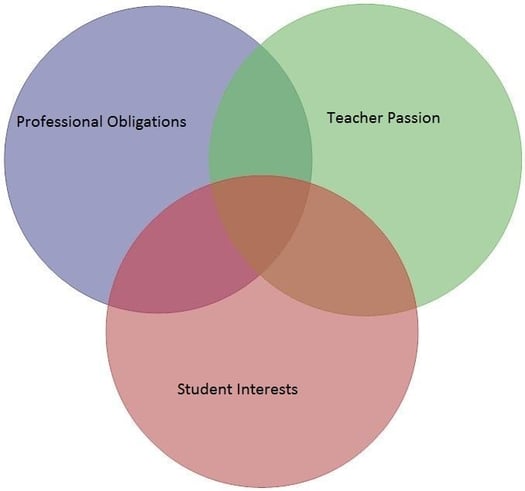By Meghan Raftery
“What makes your heart sing? If you don’t take the time to think about the answer—really think about it—you may never know the joy and success that you are truly capable of achieving.” - Carmine Gallo
This quote is a great reminder of the importance of taking the time to reflect on which projects brought our students joy and success. It’s often easiest to focus on this after the fact, but this post is how beneficial it is for educators to start with that end in mind when lesson planning.
I’ve found it helpful to take three factors into consideration when choosing new projects for my students: 1.) professional obligations, 2.) teacher passion, and 3.) student interest. Each can work, as long as it is paired with at least one other. The ultimate goal, however, is to create learning experiences that address all three.

Let’s start with professional obligations because, let’s face it, often times we don’t have a choice! Professional obligations include standards, pacing, time constraints, school-wide initiatives, learning targets, etc. If you start with professional obligations you may ask yourself:
- What unit is coming up next?
- What topics am I teaching simultaneously?
- What new strategies am I being asked to implement?
- How much time do I have for this?
- What data benchmarks do my students need to achieve?
While this is certainly not the most joyful way to begin planning, it is important not to ignore. Getting excited about a project only to find it is not permitted or will take too much time from obligations is a terrible feeling. Planning without professional obligations in mind is also a common cause of “project fatigue”, the feeling that a project is too much has gone on too long or requires instructional sacrifices that feel uncomfortable.
Another great place to start is student interests. To start a project from this orientation, it is important to be a good student of your students. If you start with student interests you may ask yourself:
- What do my students talk about during their downtime?
- What titles are they picking up from the classroom library?
- When given a choice, what are most kids picking (instructional strategies, text topics, etc.)?
- What activities were unexpectedly successful and kids are still bringing them up?
- What makes my students’ hearts sing?
It’s often great fun to plan from the orientation of student interests. You know they will be engaged and motivated to participate in the instructional activity because they truly care about it. It is also highly likely they will remember it. This is often how great school memories are made. Planning without student interests in mind often involves “project fatigue” for the students, resulting in the teacher feeling like they are dragging kids along with them.
By far, though, my favorite place to start is teacher passion. It may sound a little selfish for the project to be oriented around something the teacher cares about, but what is great about this orientation is what the teacher is passionate about usually translates to the students. To start with teacher passion, you may ask yourself:
- What do I care most about?
- What do I read/talk about in my free time?
- What lesson do I truly love to teach?
- If I had no professional obligations, what would I want to share with my students?
- What makes my heart sing?
Planning an activity based on teacher passion usually feels worth it. It feels important. It sustains a teacher who might otherwise feel weighed down by obligations, time constraints, and general burn out. Kids often remember these kinds of activities because they watch their teacher come alive and they truly get to know them. They also see a great example of passion and are more likely to pursue their own passion.
It is vital to focus on at least two of these factors for a project to be successful. Projects that meet a professional obligation and interest students, for example, will lead to items checked off the list and happy kids. Projects that connect to teacher passion and student interest will grow relationships in a classroom by leaps and bounds. The ultimate, however, is when you can connect all three.
Imagine a scenario where a 6-week project aligns to standards in multiple content areas, allowing great chunks of classroom time to be dedicated to the project. Students come in every day excited to learn and retain content like never before because they are motivated to learn it for its own sake, not to pass a test. The teacher walks on air because students care about something that matters deeply to them.
Who wouldn’t want to learn in a room like that? If we don’t try to create this kind of environment, we may never truly know the joy and success of our students, teachers, schools, and community are truly capable of achieving!